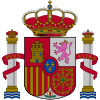Spanish/Introduction
Book definition
[edit | edit source]- Scope: This Wikibook aims to teach the Spanish language from scratch. It will cover all of the major grammar rules, moving slowly and offering exercises and plenty of examples. It's not all grammar though, as it offers vocabulary and phrases too, appealing to all learners.
- Purpose: The purpose of this Wikibook is to teach you the Spanish language in an easy and accessible way. By the end, you should be able to read and write Spanish skillfully, though you'll need a human to help with listening and speaking.
- Audience: Anyone who wishes to learn Spanish, though adult and teenage learners are likely to enjoy it more.
- Organization: This Wikibook requires no prior knowledge of the subject, and all relevant terms are explained as they are encountered. The book runs chronologically from lesson 1 to lesson 2 to lesson 3 and so on until the end.
- Narrative: Generally engaging and thorough, with plenty of examples and exercises to aid learning. Once concepts are introduced, they are repeated, building a base of vocabulary and grammar that will stay in your mind.
- Style: This book is written in British English, and the Spanish taught is generally Iberian Spanish (sometimes called Castellano in Spain), though key Latin American differences are explained as we go along. The formatting is consistent throughout, with Spanish in italics and all tables using the same formatting. Each lesson begins with a conversation, including the key grammar and vocabulary in the lesson. At the end, there is a summary, explaining what has been achieved. Exercises are linked throughout, and each new concept or set of vocabulary is accompanied by examples, each with a translation underneath.
Introduction
[edit | edit source]You are about to embark on a course learning another language, the Spanish language!
The first lesson begins with simple greetings and covers important ideas of Spanish. Throughout education, methods of teaching Spanish have changed greatly. Years ago, the Spanish language was taught simply by memory. Today, however, it is taught by moving slowly and covering grammar and spelling rules.
Again, this is an introduction. If this is the first time you are attempting to learn Spanish, do not become discouraged if you cannot understand, pronounce, or memorize some of the things discussed here.
In addition, learning a second language requires a basic understanding of your own language. You may find, as you study Spanish, that you learn a lot about English as well. At their core, all languages share some simple components like verbs, nouns, adjectives, and plurals. Your first language comes naturally to you and you don't think about things like subject–verb agreement, verb conjugation, or usage of the various tenses; yet, you use these concepts on a daily basis.
While English is described as a very complicated language to learn, many of the distinguishing grammar structures have been simplified over the years. This is not true for many other languages. Following the grammatical conventions of Spanish will be very important, and can actually change the meaning of phrases. You'll see what is meant by this as you learn your first verbs estar and ser.
Do not become discouraged! You can do it.

|
¡Aprovéchalo! |

|